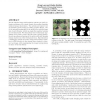Free Online Productivity Tools
i2Speak
i2Symbol
i2OCR
iTex2Img
iWeb2Print
iWeb2Shot
i2Type
iPdf2Split
iPdf2Merge
i2Bopomofo
i2Arabic
i2Style
i2Image
i2PDF
iLatex2Rtf
Sci2ools
GECCO
2005
Springer
2005
Springer
GAMM: genetic algorithms with meta-models for vision
Recent adaptive image interpretation systems can reach optimal performance for a given domain via machine learning, without human intervention. The policies are learned over an extensive generic image processing operator library. One of the principal weaknesses of the method lies with the large size of such libraries, which can make the machine learning process intractable. We demonstrate how evolutionary algorithms can be used to reduce the size of the operator library, thereby speeding up learning of the policy while still keeping human experts out of the development loop. Experiments in a challenging domain of forestry image interpretation exhibited a 95% reduction in the average time required to interpret an image, while maintaining the image interpretation accuracy of the full library. Categories and Subject Descriptors I.4.8 [Computing Methodologies]: Image Processing and Computer Vision—Scene Analysis General Terms Performance Keywords genetic algorithms, machine learning, he...
| Added | 27 Jun 2010 |
| Updated | 27 Jun 2010 |
| Type | Conference |
| Year | 2005 |
| Where | GECCO |
| Authors | Greg Lee, Vadim Bulitko |
Comments (0)

